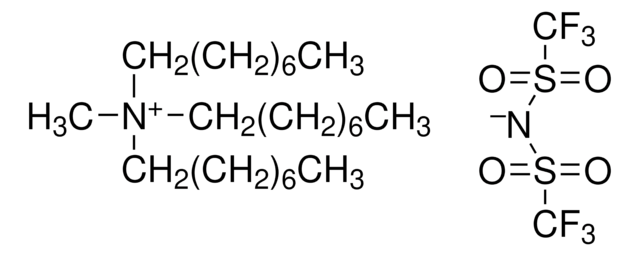86838
Tetrabutylammonium bis-trifluoromethanesulfonimidate
for electronic purposes, ≥99.0%
About This Item
Produits recommandés
Qualité
for electronic purposes
Niveau de qualité
Pureté
≥99.0% (qNMR)
≥99.0%
Forme
crystals
Pf
90-95 °C
Chaîne SMILES
FC(F)(F)S(=O)(=O)[N-]S(=O)(=O)C(F)(F)F.CCCC[N+](CCCC)(CCCC)CCCC
InChI
1S/C16H36N.C2F6NO4S2/c1-5-9-13-17(14-10-6-2,15-11-7-3)16-12-8-4;3-1(4,5)14(10,11)9-15(12,13)2(6,7)8/h5-16H2,1-4H3;/q+1;-1
Clé InChI
CFAPFDTWIGBCQK-UHFFFAOYSA-N
Catégories apparentées
Description générale
Application
- The cohesive properties and pyrolysis mechanism of an aprotic ionic liquid tetrabutylammonium bis(trifluoromethanesulfonyl)imide.: This study investigates the cohesive properties and thermal decomposition mechanism of tetrabutylammonium bis(trifluoromethanesulfonyl)imide, providing insights into its stability and potential applications in analytical and materials chemistry (Liu et al., 2023).
Autres remarques
Mention d'avertissement
Danger
Mentions de danger
Classification des risques
Eye Dam. 1 - Skin Corr. 1B
Code de la classe de stockage
8A - Combustible corrosive hazardous materials
Classe de danger pour l'eau (WGK)
WGK 3
Point d'éclair (°F)
Not applicable
Point d'éclair (°C)
Not applicable
Équipement de protection individuelle
Eyeshields, Faceshields, Gloves, type P3 (EN 143) respirator cartridges
Choose from one of the most recent versions:
Déjà en possession de ce produit ?
Retrouvez la documentation relative aux produits que vous avez récemment achetés dans la Bibliothèque de documents.
Les clients ont également consulté
Articles
Ionic Liquids serve as non-aqueous electrolytes in electrochemical applications, valued for their conductivity and stability.
Notre équipe de scientifiques dispose d'une expérience dans tous les secteurs de la recherche, notamment en sciences de la vie, science des matériaux, synthèse chimique, chromatographie, analyse et dans de nombreux autres domaines..
Contacter notre Service technique








